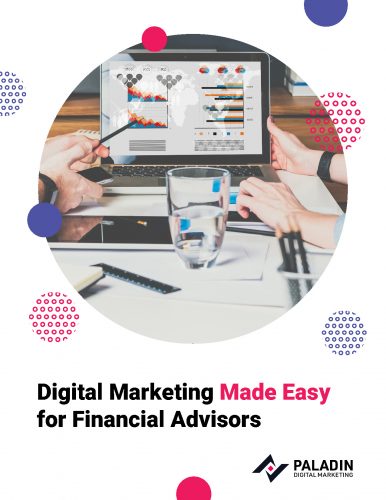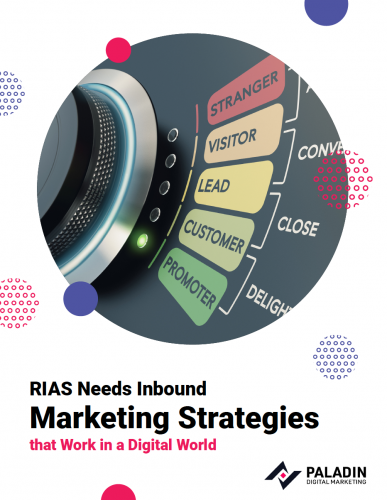Top 15 Ways to Make Your Financial Advisor Website More Credible
Let’s assume investors are surfing the Web seeking financial advisors in their communities. They visit one site after another until they have enough choices that they are ready to start their interview processes.
Which advisors do they contact? The ones they feel best about after visiting their websites and Google searching their names.
 Note the phrase, “feel the best about” which is a subjective opinion that is formed in a matter of seconds or minutes. This could be 10 seconds on financial advisor home pages or three minutes viewing content on the financial advisor websites. Our surveys show time on site is rarely more than three minutes. This is the amount of time financial advisor websites have to convert visitors into qualified leads.
Note the phrase, “feel the best about” which is a subjective opinion that is formed in a matter of seconds or minutes. This could be 10 seconds on financial advisor home pages or three minutes viewing content on the financial advisor websites. Our surveys show time on site is rarely more than three minutes. This is the amount of time financial advisor websites have to convert visitors into qualified leads.
Let’s also assume you provide the same services as your competitors and are not the largest or smallest financial advisor firm in your community. This ups the challenge for building a credible presence on the web.
Learn how Breakaway Advisors Use Digital Marketing To Build Credibility And Trust
Credibility is critical when investors are making Yes or No decisions in a few seconds or minutes. There are no second chances because investors rarely return to financial advisor websites that they find lacking for one reason or another.
Electronic First Impression
What will investors see on your website’s homepage, above the fold, no scrolling required. In general, it is going to be your name, logo, and a brief message. Is the message promotional, informational, or educational? Does your name instill confidence or detract from it? What they see either resonates with investors visiting the site or it does not.
How do investors make this determination so quickly? They are visiting a lot of financial advisor websites and some resonate more than others. So the number one objective is to make sure your name, logo, and content deliver the right first impression in 10 seconds or less.
Read our blog article: Do DIY Financial Advisor Websites Work in a Digital World?
Names Can Be Brands

When does the name of a firm become a brand? It happens when the name stands for something meaningful that investors put value on. Expertise and integrity are the top two features that matter most to investors who are seeking financial advisors.
How do you prove your firm is an expert without a GIPS compliant track record? How do you prove you are a trustworthy firm? Being a financial fiduciary is not enough.
Let’s face it, financial advice and services is a conceptual sale - by far the toughest kind of sale. Credibility is a goal that is achieved by very few firms that are not brand names - nationally and locally. The more credible your firm is the more likely investors will believe your firm is a legitimate, trustworthy expert.
The Right Navigation
Navigation adds to your credibility when you make it easy for investors to find the information they are seeking. This could mean you have nothing to hide. At a minimum, it means you care enough to make finding information on your website easy.
The five top-line navigation categories of information about your firm are:
- About Us
- What We Do
- Who We Service
- Why Select Us
- Resources
Resources can include your blog, eBooks, videos, and other types of relevant information.
The Right Information
The right information will vary by investor. That makes the delivery process that much tougher. What we do know is you have to provide high-quality information that is competitive with the other websites that investors are visiting.
So if you don’t know what is important to individual investors, and you don’t know what is appealing on competitor websites, how do you determine what to publish on your website?
The simplest way to obtain this information is to talk to your current clients and ask them a few pertinent questions. For example:
- How did they find your firm?
- Did they visit your website before the first contact?
- What did they see on your website that they liked?
- Was there any missing information?
Transparency is Critical
 A touchy subject for many financial advisor websites is transparency. How much they should disclose. For example, an advisor may not be willing to disclose their fee schedule, but they are willing to describe how they are compensated - an asset-based fee. Most advisors do not disclose fee schedules for competitive reasons.
A touchy subject for many financial advisor websites is transparency. How much they should disclose. For example, an advisor may not be willing to disclose their fee schedule, but they are willing to describe how they are compensated - an asset-based fee. Most advisors do not disclose fee schedules for competitive reasons.
How do you instill trust by withholding important information? You may believe investors will not know the information is missing, but that may not be true if your competitors happen to disclose the information you are omitting.
Specialists Have An Advantage
Investors will tell you they prefer specialists handling their money. They would not go to a real estate attorney to obtain a will. They don’t go to a brain surgeon to get a hip replacement. You get the point. People are conditioned to seek specialists who have a better understanding of their situation, needs, concerns, and goals.
A lot of organizations have created designations and certifications for specialists. For example, the advisor who works with seniors or the advisor who works with divorcees. These designations help prove expertise if the credential is obtained from a credible organization. At this time there are more than 250 designations for financial advisors and 30% or more are fake.
It is not enough to work with people who have investable assets that meet your firm’s minimum asset requirement. If possible, you should work with the particular types of clients that make-up your current client base. And, then you should disclose this information on your website. For example, you could publish 40% of your current clients are Baby Boomers who are transitioning from their working years to their retirement years. This definitely adds to your credibility.
Read our blog article: Should Financial Advisors Publish Client Testimonials?
The Right Free Offers
A high percentage of investors are not seeking financial advisors when they visit their websites. They are seeking financial information that educates them on topics that are important to them.
How do you know what information they are seeking? You don’t and there is no use trying to guess. Many advisors will have a Resource Center on their websites where investors will find:
- Access to blog articles
- A video library
- eBooks
- Whitepapers
One type of content is designed to promote your firm as a relevant expert. This could be an eBook that requires registration to view it. Another type of content conveys the personality of your firm and why investors should trust you. This can be best communicated in a library of videos.
There is a good chance that investors seeking financial information will end-up on your drip list. You will drip on them until they are ready to begin interviewing financial advisors. At that point, you will have a serious competitive advantage because the investors have had time to get to know your firm.
The Our Team Page
One of the most visited pages on financial advisor websites is the Our Team page. This makes a lot of sense. Investors want to see the credentials of the advisors who will be influencing or controlling their financial decisions.
For credibility purposes, if you have an Our Team page, make sure there are enough professionals to comprise a real team. This could be planning, investment, and administration professionals. Again, your credibility is at stake if you don’t have a real team.
No team means you have to be more creative to protect your credibility. For example, don’t call it an Our Team page. Instead, call it an Our Founder page or an Our Principals page. The latter creates an opportunity to practice transparency when you disclose who owns your firm.
The Why Select Us Page

Another credibility building page is Why Select Us. On this page, you should give investors five to seven
important reasons why they should select your firm to be their financial advisor. This is tougher than it sounds because you do not want to undermine your own credibility.
The reasons for selecting your firm should really resonate with investors. And, most importantly they should be expressed as benefits and not just features.
What if you have trouble coming up with five to seven important reasons why investors should select your firm? You should view this as a challenge that has exposed some of your weaknesses. This is your opportunity to shore up these weaknesses. And, you have the opportunity to fix problems and add to your credibility at the same time.
The Resources Page
Let’s assume the content on your website is relatively static, however, there are numerous opportunities to add to your credibility by producing new content on your Blog and under the Resources tab.
You know fresh, original articles will be published on your blog on a regular basis. This is the kind of content that will improve your Google ranks for keywords that drive the right types of visitors to your website.
Other content can be published under your Resources tab:
- eBooks
- White papers
- Webinars
- Video Libraries
You should be adding new content every month to give investors reasons to keep visiting your website. A lot of this content should also be integrated into your drip email system.
New, relevant content is a major credibility builder.
Contact Points
Another important feature on your website is your accessibility. You should make it very easy for investors to initiate contact with your firm.
There is always the Contact Us function on the top navigation bar. You should also make sure investors feel safe when you ask for their contact information.
CTAs or Calls To Action are another way to make it easy for investors to contact your firm. Most often this will occur on a landing page.
Benefits Versus Features
Reading page after page of information about your firm may become boring fairly quickly. That’s because the information is about your firm and not about the investors who utilize your firm’s services.
On the other hand, a well-designed financial advisor website will describe a feature of the firm then point out how their clients benefit from the feature.

For example, a financial advisor is a Registered Investment Advisor or an Investment Advisor Representative. This is a feature, but how does that benefit investors who are clients of the firm? One answer is the advisors are held to the highest ethical standard in the financial service industry. Another benefit is they can charge a fee for their services. Therefore, this could mean the advisors are inherently more trustworthy based on fewer conflicts of interest. This is a great example of a feature that adds to the credibility of your firm.
Investors buy benefits and not features. In fact, some features actually turn investors off. For example, an advisor provides a lot of content about their investment process. But, most investors don’t care about advisors’ processes. Every advisor has one. A lot of them are the same. Most investors don’t understand them. Therefore, they are another type of distraction.
Speed Has Become a Necessity
If you want your financial advisor website to rank well in Google it better have a fast load time. That is 2.8 seconds or less and a speed rank of 90 or higher for desktop and mobile devices. This is important to Google because it wants its users to have a positive experience with results so they will come back and tell their friends, family, and associates. The more positive the experience, the more people use Google, the more it can charge advertisers to monetize its traffic.
Google users that have bad experiences, for example, excessive wait times, may exit Google and use a different search engine in the future. Therefore, Google rewards fast websites and penalizes slow websites.
Avoid Clutter
Many advisors load their websites with clutter thinking it will make them look more credible. Ironically it can do just the opposite. Clutter is not the impression that will cause investors to contact your firm.
What are examples of clutter?
- Dysfunctional free offers (no one uses them)
- Surveys
- Calculators
- Irrelevant content
- Stock pricing services
Or, anything that competes with the Wall Street Journal, Bloomberg, Kiplinger, and other brand names that provide financial news.
Use of Video
 Video is an investor-friendly form of communication because it does not require them to read large volumes of written text. In fact, they can learn what they need to know without reading anything. All they have to do is watch and listen.
Video is an investor-friendly form of communication because it does not require them to read large volumes of written text. In fact, they can learn what they need to know without reading anything. All they have to do is watch and listen.
They don’t even have to take notes. You can provide access to the information at the end of the video. Perhaps you provide an eBook that summarizes the content in the video that may be a webinar.
There is another major feature of video that should be considered. It is difficult to convey the personality of the firm in print. It is very easy to do in a video. Let’s call it giving the viewer a warm, fuzzy feeling about your firm.
Videos are a very effective way to give investors some insight into the personality of the firm and how it interacts with its clients. This in turn adds to the firm’s credibility when investors are making subjective determinations about initiating contact.
Updated 9/13/2021




